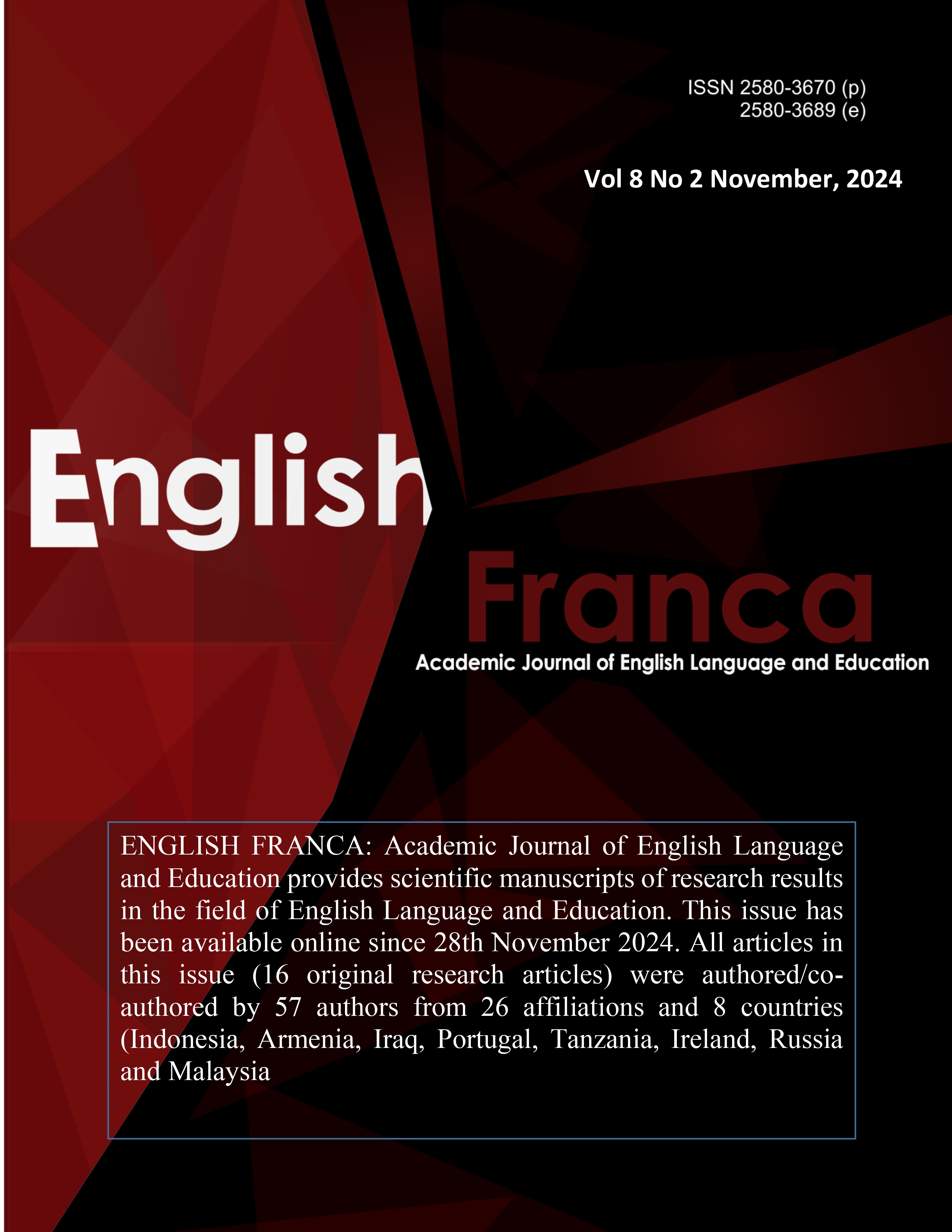The Word Formation of Blending in Humor Language: A Study of a Twitter Account “9GAG”
DOI:
https://doi.org/10.29240/ef.v8i2%20November.4174Keywords:
9GAG, blending, humor language, Twitter, word formationAbstract
The purposes of this study were to analyze the blended words found in 9GAG posts on Twitter in conveying humor and discover their meanings. This study applied a qualitative descriptive approach. The data were collected from 9GAG posts containing blended words in conveying humor through observation and documentation analysis. The study's findings indicated that there were 15 blended words found in 9GAG posts in conveying humor. Furthermore, the meanings obtained by the researchers differ as well. Many words were semantically similar to those listed in dictionaries, while others had an unconventional meaning, which can be used and interpreted only in certain contexts. Additionally, these findings were useful as language updates by listing new words discovered in the dictionary. It can rapidly enhance people’s linguistic understanding, especially EFL teachers and students who teach and learn English using this account. So, the misinterpretations and ambiguities that occurred this time could be minimized.
Downloads
References
Alhamid, T., & Anufia, B. (2019). Resume: Instrumen pengumpulan data. Sekolah Tinggi Agama Islam Negeri (STAIN).
Arnold, I. V. (2011). The English Word. Moscow: High school. 1986. 2. Ashurova DU Cognitive Stylistics: views, approaches, perspectives. Stylistics in the Light of Modern Linguistic Trends. Papers of Scientific Practical Conference.—Tashkent, 3, 30–80.
Aulia, R. S., Ramadhani, A., & Siregar, A. N. (2024). Word formation in the Jakarta post Archipeelago article. International Conference on Humanity Education and Society (ICHES), 3(1).
Awwaliyah, M. (2024). Analysis of Code Mixing Within Jaksel Youths on The Podcast Kesel Aje. Institut Agama Islam Negeri Madura.
Bauer, L. (2024). The semantics of English nominalizations: How much is usage? In Nouns and the Morphosyntax/Semantics Interface (pp. 399–414). Springer.
Bednárová-Gibová, K. (2014). Some insights into portmanteau words in current fashion magazines. Jazyk a Kultúra, 5(19–20), 0.
Embu-Worho, V. V., & Gayatri, Z. Z. G. (2018). An analysis of the use of acronym, clipping, and blending on Twitter. Netizens of the World #Now: Elevating Critical Thinking through Language and Literature, 160.
Enarsson, A. (2007). New blends in the English language (pp. 1–29).
Karjo, C. H. (2024). Phonological construction of Indonesian blends. Linguistik Indonesia, 42(1), 113–126.
Kemmer, S. (2003). Schemas and lexical blends. Amsterdam Studies in the Theory and History of Linguistic Science Series 4, 69–98.
Mahasneh, Anjad A Bashayreh, H. (2021). A semiotic translation of memes: Trump’s visit to Saudi Arabia as a case study. Young.
Meilantari, N. L. G., & Aritonang, B. (2024). Clipping and blending words in Japanese internet Slang: Philosophical perspective. Mahadaya: Jurnal Bahasa, Sastra, Dan Budaya, 4(1), 11–18.
Miles, M. B., Huberman, A. M., & Saldaña, J. (2014). Qualitative data analysis: A methods sourcebook. Sage Publications Inc.
Muna, N. A., & Arifianti, I. (2024). Register lingual pada jual beli online dalam aplikasi Shoppe. Transformatika: Jurnal Bahasa, Sastra, Dan Pengajarannya, 8(2), 486–499.
Pelkey, J., & Augustyn, P. (2023). Semiotics in evolutionary linguistics. Bloomsbury Semiotics Volume 2: Semiotics in the Natural and Technical Sciences, 2, 93.
Plag, I. (2003). Word-formation in English. Cambridge University Press.
Pranoto, B. E. (2021). Insights from students’ perspective of 9GAG humorous memes used in EFL classroom. Thirteenth Conference on Applied Linguistics (CONAPLIN 2020), 72–76.
Rosell-Aguilar, F. (2018). Twitter as a formal and informal language learning tool: From potential to evidence. Innovative Language Teaching and Learning at University: Integrating Informal Learning into Formal Language Education, 99–106.
Saifudin, A., Risagarniwa, Y. Y., Citraresmana, E., & Sidiq, I. I. (2024). From pictures to words: A linguistic approach to comic strip humor. International Journal of Society, Culture & Language, 12(1), 396–411.
Tana, I. A. R. (2023). Penggunaan gaya bahasa sinisme dan sarkasme oleh netizen Indonesia di Twitter (The use of cynicism and sarcasm by Indonesian netizens on Twitter). Universitas Hasanuddin.
Theresa, A., & Rizky, C. A. (2018). Blending words in social media (Twitter, Youtube, Instagram). Netizens of the World #Now: Elevating Critical Thinking through Language and Literature, 58.
Wijayava, R., Arumi, S., & Giyatmi. (2017). English blends found in social media. Journal Abitrer, 4(2).
Yule, G. (2010). The study of language (Fourth Edition). Cambridge University Press.
Downloads
Published
How to Cite
Citation Check
License
Copyright (c) 2024 Rizka Sylvia

This work is licensed under a Creative Commons Attribution-NonCommercial-ShareAlike 4.0 International License.
Authors who publish with this journal agree to the following terms:
- Authors retain copyright and grant the journal right of first publication with the work simultaneously licensed under a Creative Commons Attribution License (CC BY-NC-SA 4.0) that allows others to share the work with an acknowledgment of the work's authorship and initial publication in this journal.
- Authors are able to enter into separate, additional contractual arrangements for the non-exclusive distribution of the journal's published version of the work (e.g., post it to an institutional repository or publish it in a book), with an acknowledgment of its initial publication in this journal.
- Authors are permitted and encouraged to post their work online (e.g., in institutional repositories or on their website) prior to and during the submission process, as it can lead to productive exchanges, as well as earlier and greater citation of published work (See The Effect of Open Access).









